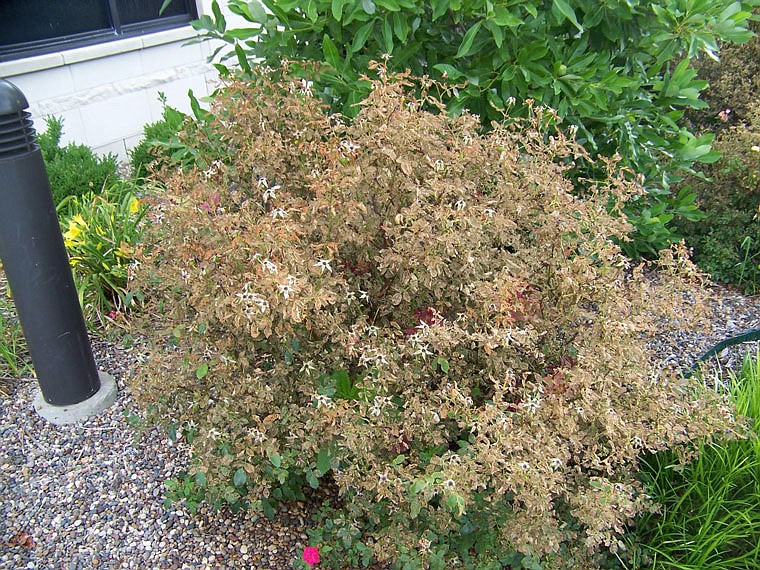Q. The Japanese beetles have almost formed a swarm and ate most of the upper leaves of a large elm tree. What is going on with them this year, and will it kill my tree?
A. Japanese beetles are having a huge year. Our trap here at the Extension office caught double its highest ever previous catch (which was in 2012) with more than 4,000 per day (July 8-11). I hope that is the peak, and we'll start the decline.
Mature trees (or shrubs) are considered able to handle this defoliation, but they look lousy afterward (note photo of a Knock Out rose). Newly planted trees or shrubs should be protected. Sevin is considered the most effective product to kill Japanese beetles; liquid Sevin is safer for bees. It would be very challenging to spray a large tree, but it would protect it. Unfortunately, it would have to be applied two or three times during their high numbers.
If you want to protect a tree or shrub in advance, there is an Advanced Bayer 12 Month Tree & Shrub Insect Control Landscape Formula II, advertised as "a great value for more mature trees or a large number of trees." It is selling online for around $100 per gallon. The label specifies to use ounce per inch of distance around the trunk. A small to medium tree will have a trunk circumference of about 30 inches, so would be about a pint (16 ounces) to treat (1/8 of a gallon, or about $13). A medium tree will have a circumference of 60-80 inches so would take about 1/3 of a gallon ($35). A large tree might take almost the entire gallon. One should treat a tree or shrub a few weeks before the pest arrives, so early to mid-May would be the right time to use this next year.
Having a plant protected in advance helps reduce the beetles from ever descending upon a particular plant in large numbers. Odors emitted from beetle-damaged leaves seem to attract more beetles, referred to as an "aggregation trait," or maybe better put, stimulating a feeding frenzy. And this is much as you described, almost like a swarm. So in this instance, one could quite literally say "an ounce of prevention is worth a pound of Sevin!"
Q. Japanese beetles are on my blackberries. What can I spray them with?
A. Ortho's Flower, Fruit & Vegetable Insect Killer Concentrate has a very broad label that includes all common fruits and lists Japanese beetles as a pest it controls. It is about the only insecticide for home gardeners that is labeled for blackberries with a relatively short pre-harvest interval (the time you wait after spraying to harvest). For that, it is labeled as one day. I suggest you call retailers to see if they carry it, or check online, as it was only released this year. Be sure to read the label carefully and follow all instructions and heed any warnings.
Q. I live in Columbia and just this last week we had toads coming into our house. We never had that problem before. Why might they be doing this?
A. The big rain! Most areas of Columbia had 6-7 inches of rain between July 2-3. We've seen other incidents of strange wildlife showing up in houses with excessively rainy periods, like millipedes and the wet years of 2008-09.
Q. I have these bees similar to large bumblebees going in and out of a hole in a wooden cabinet. Are these a problem? Will they sting me?
A. These are probably carpenter bees, which are fine in nature but not when in our wood structures. They tunnel in, raise their broods and weaken the wood. Ironically, the aggressive males do not have stingers, but their confidence acts like they should when they zoom in and literally get in your face. The much more furtive female does have a stinger. Our MU publication on carpenter bees (extension.missouri.edu/p/G7424) provides this easy and safe method to control them:
Treat each individual tunnel opening with insecticide. Tunnel openings should be treated after dark when the bees are calm and in the nest, preferably on cool nights. Use a pressurized can of bee/wasp spray that shoots a stream of liquid into the tunnel and immobilizes the bees. A few days after treatment, tunnels should be filled with caulking compound, plastic wood or a tight-fitting (-inch) wooden dowel glued in place. If paint would be acceptable on the wooden surface, painting it will discourage further attack by other carpenter bees.
The Central Missouri Master Gardeners are a volunteer group of 191 members, 122 of whom are Cole County residents, who maintain 11 beautification sites in Cole County. Master Gardeners must complete a basic training program of at least 30 hours of horticultural training including landscaping, lawns, vegetables, flowers and fruits, as well as 30 hours of volunteer service.

